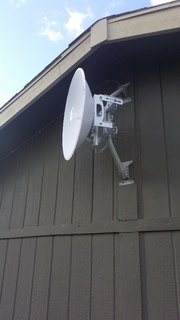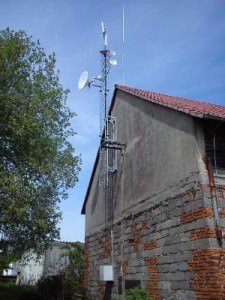Building the Infrastructure of Decentralized Civilization. Part 1 - Communications
“An examination of the technologies and systems enabling the rise of a new model of civilization, and of the entrepreneurial opportunities this presents.”
Part 1. Communications
As you may have noticed, the rise of technologies and techniques of disintermediation, the removal of the middleman, is taking place in almost every area of society. Monopolistic & politically protected industries are being suddenly disrupted by decentralized network-organized systems and services, and the business opportunities that result are numerous and rewarding. It’s an exciting time to be alive, and there’s a really cool potential future which is ours for the building.

I’ll start this series off with a look at an opportunity that I’ve been involved in for almost 10 years but is still just getting rolling, which is the locally owned & operated ISP. A once heavily regulated or State-owned industry in many countries, telecom has been radically disrupted in the past decade by both new technology, and by software services over the Internet such as Skype or VoIP replacing long-distance toll calling. There is a great entrepreneurial opportunity here, both freedom-promoting and financially rewarding.
Consider how often you hear people complaining about their Internet service, wishing they weren’t stuck with 1 or 2 monopolistic national providers. You read of the vast sums of government money that it requires to bring broadband to rural areas, the years it will take, and the high prices and slow speeds that result from these enormous expenditures.
At least that’s the dominant storyline. But quietly developing in rural areas all over the world, is a 21st century solution. The use of outdoor data radio equipment using directional antennas to transmit broadband has been around for about 20 years, but since 2008 the technology has rapidly matured and reduced in cost to the point where it now creates an opportunity for small business to directly compete with large national providers.
A locally owned and operated broadband network is fairly inexpensive to set up, takes only a few people to operate and grow, and can provide a good income once established. It isn’t just a great business opportunity however, but can create a zone of increased privacy and autonomy. For freedom-minded communities, this is a valuable asset which provides for direct communication that remains within the local network. As most of us are aware, the large Telcos are essentially extensions of the National Security State, and by building your projects on them, you're operating on enemy territory - behind the lines.
But it's now possible to build a completely parallel telecommunications network, using affordable, powerful fixed-wireless radio equipment. In doing so, you’ll be building not just an area of increased freedom to communicate, but also a distribution platform that creates more opportunities. If you do some research you’ll find many open-source projects which you can use to replace all the intrusive mainstream services such as Skype, Dropbox, GMail, Facebook & Youtube.
We could see local e-government, perhaps using a blockchain-based system like Bitnation and some DAO / DAC concepts. Another potential service is a local online farmers market using the OpenFoodWeb platform. Someone could set up a Diaspora pod to provide a social-networking service, a FreeNAS server for local file storage and backup services, a Jitsi-Meet or Spreed.me server for video/audio communications, Cyclos to facilitate the use of local currency or time banks, and so on. This is a whole other series of articles, which we'll get into down the road!
---
So there are a few of the reasons WHY, now let’s look at some examples.
Starting with a simple but useful scenario, lets’ suppose that two freedom-minded friends live close to each other, and want to share data privately. Their houses may be several miles apart, but are within sight of each other. A point-to-point link can be built using a pair of 5Ghz directional radio units at around $100US each, giving them a private connection of potentially 200-300 Mbits/sec. A few other small costs such as network cable, mounting arms and so on, push the price up to a total of around $350. Not very much for an encrypted, high-speed link! Just put a radio on each person's house, as shown in the picture below, follow the easy-to-find online guides for setting up a radio 'bridge' connection and you'll have a link!

Here's an example of a longer-range 2-foot (620mm) antenna on a house (one of my customers). You can see the AirMAX-M5 radio unit clipped on the back, the 2 satellite mounting arms supporting it (with lots of lag screws into the wall, wind is strong!) and the ethernet cable running up and along the eves to the left. These antennas are good for 30+ miles with clear view between them.
Now, let’s get a bit more complex. Say your houses CAN’T see each other, but a 3rd friend’s house can see both of yours. Put a radio on their house in what’s called AP mode, and then two radios on your houses in ‘client’ or station mode, linked to the AP similar to two laptops connected to a wifi router. Now you have a Point-to-Multipoint (PtMP) network with 3 houses connected, and the initial seed of a local WISP. This isn’t a ‘mesh network’ like several projects are attempting to build, but a star topology and eventually a ring-star network which provides much greater reliability and speed.
And now, of course you want to see what you can REALLY do with this stuff.
https://www.youtube.com/watch?v=F70xXce5VpU&feature=youtu.be
How about building a viable, alternative to the corporate-owned, government controlled grid. Off-grid power, long-range radio units and a little labor, and distributed telecommunications infrastructure is not just a city mesh-network toy anymore, but a real possibility.
The final example, that of a basic WISP (wireless ISP). So, there are 3 key ingredients for successfully starting a local WISP. You need a decent number of potential customers in a poorly served area, you need a source of wholesale (resellable dedicated-circuit) bandwidth from a larger provider, and you need a high and visible spot to locate your distribution equipment. Given those are taken care of, you’ll need a few things that any small business would, such as LLC registration, a bank account, billing system such as Freshbooks or Quickbooks, and a healthy appetite for dealing with technologically unsophisticated customers. I know, yuck. But hey, it's not too hard once you get into it.
You or someone will be spending a decent amount of time on a ladder, and drilling holes in people’s houses, so insurance is also mandatory. There’s a usually bit of quarterly and yearly government paperwork, though this is a very lightly regulated industry compared to most. It’s new enough to have escaped bureaucratic suppression thus far, and evolving rapidly enough to outpace potential attempts at ‘competition by regulation’.

How's your head for heights?
Dedicated bandwidth is something you’ll want to grow into, after you have a test network up and running. It’s usually delivered to you via fiber in a commercial building and will be your biggest single expense costing hundreds or thousands a month, but it’s all yours and guaranteed to run 100%. It’s what every home customer wants, but could never afford. All ISPs earn income by purchasing ‘dedicated’ bandwidth at great expense and reselling ‘best effort’ bandwidth to customers at a more acceptable price range of $30-50/month. That’s why you see ‘up to’ in most advertising. This works because not everyone uses their service at the same time. During peak usage periods in the evenings, larger national ISPs will usually let things get overloaded and bog down, games will lag, Netflix will buffer. A good local ISP (you) will watch its traffic loads and purchase more dedicated bandwidth if things are maxxing out. The word will get around that you offer greater utility for the price, and you will take their customers!
Now this isn’t a no-money-down startup; even a single-site barebones ISP will be in the $10k USD range, and you’ll need some ‘burn’ money to pay your bandwidth and other monthly bills while you hook up customers as fast as you can. You could start this on a shoestring (which is what I did) and make it, but it’ll take quite a bit of luck and timing. Ideally you will have access to some savings or an investor to get your business off the ground.
And it’s certainly not a passive income business. It takes a lot of work and attention to operate a WISP, but it’s worth it. A mature local ISP can bootstrap you up well into the middle class income bracket.
Remember, once you’ve built this network platform you’re uniquely positioned to bring freedom-enhancing services to your area. Running an ISP for your area puts you on everyone's friends list, inside their 'Dunbar's Number' group. This is an incredibly valuable thing. Promote freedom, decentralization, be the glue of your community. Promote the use of Bitcoin, and accept it for bill payment. Help other businesses get going with BTC. Set up some of the open-source projects mentioned above, and add value to your network while building a stronger community!
So there it is, a 21st century business opportunity that can be pulled off with a small amount of capital and a few somewhat athletic IT entrepreneurs. Keep an eye out for follow-on posts, where I'll be sharing more articles and video of some of the day-to-day work that it takes to build an independent communications system.
---
I’m available at my consulting site http://www.hyperborean.io for questions, design work, onsite consulting and advice, and look forward to helping others develop independent networks in their area!
Hell YES ! I can't believe i found YOU !!! We really need to talk, lol
Nice point of view
I wrote a post right now about this paradigm shifts
https://steemit.com/steemit/@cokaum/how-steemit-can-change-the-way-we-all-do-business
Let's change the way our society do things
Let's embrace a decentralized civilization!
It's exciting to have a front-row seat for all this.
Spectacularly cool. Does the FCC have any grounds to shut you down? Our are you using some sort of public channels?
I love anything that has to do with sneaking in under monopolies. :)
Oh, they'd like to try! We WISPs use the unlicensed bands (900Mhz, 2.4Ghz, 5.1-5.8Ghz, 24Ghz & 60Ghz) to do our thing. There's so much stuff out there in those bands now, that there's no way they can take the frequencies back. The FCC did recently change the 5Ghz rules in an attempt to restrict our ability to do longer range high speed shots, but the gear is evolving faster than the bureaucrats can keep up!
It's awesome, and the upcoming generation of stuff will let our little 2-man outfit go toe-to-toe with the big guys and deliver fiber-like speeds...
Very nice article.